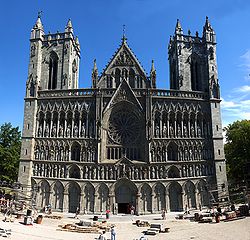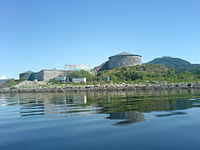- Olav Engelbrektsson
-
Olav Engelbrektsson [1] (c. 1480–1538) was the last Catholic Archbishop of Norway. As well as being a religious leader, Olav was also a political figure[2];
The Archbishop served as leader of Norway had during this interregnum period, serving as a defendor of the Catholic faith as the Reformation swept through northern Europe. His cousin Kristoffer Trondson defended Norway, until 1536.[3] As Archbishop, Olav built Steinvikholm Castle outside Trondheim.
During his tenure Olav tried and failed to break away from the union that bound Norway to Denmark. The failure of this effort, in 1536, and the resultant subsumption of Norway under the Danish crown marked both the end of Catholicism, as well an end to Norwegian sovereignty. In 1537, Olav went into exile from Norway, leaving behind St. Olav's shrine and other valuables.[4]
Exiled, Olav departed with the records of the church for mainland Europe[5]. He was (possibly unfairly) given the reputation of having looted Nidaros Cathedral[5].
 Nidaros Cathedral. Olav Engelbrektsson was the last Archbishop to reign in this former site of Catholic pilgrimage.
Nidaros Cathedral. Olav Engelbrektsson was the last Archbishop to reign in this former site of Catholic pilgrimage.
Contents
Last Archbishop of Norway
Sixteenth century Norway had no university; as such, Olav, like most of the Norwegian upper classes, was educated abroad. He studied at the University of Rostock, Germany.[6] He returned to Norway to serve as Archbishop in 1523. His role was highly political in nature, as Archbishop he was leader of the Norwegian Council of the Realm, and at this time, Norway found itself with no King.
Dano-Norwegian conflict, 1532-1537
The Council of the Realm elected the Danish Frederik I as King of Norway. Yet Olav greatly disliked and distrusted the Danish king and worked assiduously to prevent Frederick's coronation as King of Norway, managing to delay it three times.[7] Olav preferred that the former Danish King Christian II, nephew of the current Danish King Fredrick, should return as King of Norway.
In March of 1532, Olav was recorded as paying 21 kg of silver, in minter form, to mercenaries hired by Christian II during his unsuccessful struggle against Fredrik I for the throne of Denmark-Norway. Following Christian's defeat, Archbishop Olav Engelbrektsson was fined heavily for this support to the amount of 15,000 Danish marks, the equivalent of about 134 kg of silver, to be paid in three installments [8].
The 1533 accession of a new Danish king, Christian III escalated the political situation; here was a king who not only continued the claim over Norway, but who actively promoted the Protestant Reformation there. Being in that Olav was the representative of the Vatican in Norway, this of course was not a welcome gesture. As a response, Olav attempted to formalize Norwegian sovereignty and independence vis-a-vis a meeting of the Norwegian Privy Council at Bud.
Tensions rose in 1536, when the Danish Privy Council declared Norway annexed. A Danish earl Vincens Lunge was sent to Norway to enforce this new mandate on behalf of the Danish Crown; the response was not friendly; Lunge was murdered by followers of Olav. The actual murder of the earl was said to have taken place at the hands of Olav's cousin, Admiral Kristoffer Trondson.[9], Norway's functioning military commander who had been active in battle against Danish ships, funded by capital raised principally from the Netherlands.
Norway's defeat, Olav's exile
In 1536, Olav fled Steinvikholm Castle to Nidarholm Abbey. In 1537, he took exile from Norway, coming to Lierre, in Brabant (Belgium), where he died in 1538. He is buried under the high alter of the Church of Saint Gommaire, Lierre.
His departure marked the subsumption of Norway into Denmark-Norway; Norway was declared, formally, a part of the Danish Kingdom, and the Danish king was automatically King of Norway until 1814.
Olav Engelbreksson: A "Midnight opera"
The drama of the Olav Engelbrektsson saga, including the violent murder of Nils Lykke is reenacted in a modern evening-opera, in Trondheim: Olav Engelbrektsson. The murder of Nils Lykke is reenacted in the song, "Kristoffer Rustung".
The opera was created in 1993, and remains ongoing as from 2009; it is held biannually held on the premises of Steinviksholm Castle during the summer months, at night. It is held only every-other-year such as to protect the premises of the historic castle grounds. The opera was originally funded with grants from the Norwegian Ministry of Culture.
Norway gained her independence in 1905; Norwegian independence is but 100 years old. As such, interest in history "long lost" during the 400 years of Danish and Swedish colonization, has rendered this opera - and figures such as Olav Engelbrektssen - very popular in 21st century Norway[5].
References
- ^ Olaf, Olavus; Engelbertsen.
- ^ National coins issued under the mark of Olav Engelbrekktson, 16th Century Norway
- ^ Thomas Kingston Derry, The History of Scandinavia (2000), p. 92.
- ^ http://www.zum.de/whkmla/region/scandinavia/norway15131559.html
- ^ a b c Hoem, Edvard (2006) Come Forward Prince!, Aschehoug Agency Publishers] -
- ^ http://freepages.genealogy.rootsweb.ancestry.com/~maggiebakke/olav.html
- ^ http://www.dokpro.uio.no/umk_eng/myntherr/olav_eng.html
- ^ McLees, Christopher, The late medieval mint workshops at the Archbishop's Palace, Trondheim, Antiquity , June, 1994
- ^ Ibid.
External links
- (Norwegian) Biography
Categories:- 1480 births
- 1538 deaths
- Norwegian bishops
- Norwegian late-medieval history
Wikimedia Foundation. 2010.

